
Tech giants are facing threats of regulation on many fronts, but California is poised to become ground zero, as a new feature for Amazon's Alexa suggests.Read More
from Social – VentureBeat http://bit.ly/2MmQp7R

I have to come up with lots of article ideas. I have a few methods, including reading industry-specific content and following links they reference. This morning, I was sitting in ...
The post A Process for Generating High-impact Article Topics appeared first on Practical Ecommerce.
In today’s world, for a business to thrive, it needs to produce engaging content that will attract people’s attention and keep them interested. Without content, all your business will become is an afterthought, which means that consistent content publishing is essential.
When the topic of content comes up, blogging immediately comes to mind, but there are other forms of content that businesses can rely on. You can use social media posts, publish a book or appear on podcasts.
Appearing as a guest on podcasts is an effective way of getting more eyes on your business. One reason why this tactic works is because listening to podcasts is a convenient way to learn and acquire knowledge. With podcasts, the audience doesn’t need to read through countless paragraphs to learn about something. You can easily consume information even when you’re on the go – while you’re driving, having your morning coffee or even when you’re at the gym.
As a business owner, this convenience is something you can capitalize on. By getting on some of the top podcasts in your niche, you’ll be giving your business a competitive advantage through greater exposure, as well as a host of other benefits.
Becoming a guest on a popular podcast can benefit your business in a lot of ways. For one, you’ll be able to leverage the podcast’s hundreds of thousands or millions of followers, which can help bring your business in front of a lot of new eyes (or ears, as the case may be) and potentially gain them as followers of your brand, too.
But more than improving your viewership and following, podcasts provide you with a platform to share your story. It gives you the opportunity to let people know what your business is all about, what your products and services are, and how people can benefit from them.
The huge advantage of all this is that you’re able to market your business practically for free. This is a fantastic opportunity considering the exposure that your business will get just by speaking for a few minutes. The information you’ll share can make a big difference in people’s lives, and if it can help them solve their problems, it will definitely put you in a position of authority.
Related Content: 7 Creative Ways to Monetize Your Podcast

Another great benefit that podcast guesting brings is that it helps improve your business’ searchability. We all know how important SEO is to any business, and if you’re still not convinced, here are some of the ways that this tactic helps your rankings:
Podcast hosts create show notes for every episode they complete which include a summary of the conversation or even a full transcript. This is where the audience finds links to your website, your product offers, and social media profiles, like this example of a Growth Everywhere podcast episode:

It is through these backlinks that people find their way to your business, especially those who do not actively follow you yet.
Another benefit that these backlinks bring is that they make your business more attractive to search engines, especially if the episode is on YouTube and the page is page optimized. Appearing at the top of search results makes a huge difference, especially if visibility and searchability are your business’ weaknesses.
These natural backlinks provide people with an easier way to discover your business and learn more about it instead of having to manually searching for it. It’s basically free promotion that is not too salesy — something people appreciate.
Learn More:
Podcast show notes are evergreen, which means they don’t have an expiration date and will always be accessible to anyone. What does this mean for your business?
For one, it means that those backlinks will always be available for people to click on and visit your website or social media channels. If someone is an avid fan of the podcast, for example, he or she can still listen and find you in the show notes years from now.
Whatever SEO juice these show notes get will keep on driving traffic and rankings for as long as the page is live. This will help bring consistent referral traffic to your page even if you did the actual podcast guesting five or 10 years ago. Appearing on more than one podcast is, of course, highly recommended because the footprints you leave on the show notes will continue to serve you for as long as the pages are active.
Learn More: 5 Types of Guest-Post Content that Support Your Link-Building Efforts
What makes appearing on podcasts great for brands is that apart from the backlinks and free promotion, you’ll also get the opportunity to pitch other sites so you can get more backlinks in the process.
If you have other businesses or partner sites where you have existing backlinks, referring them to these podcasts will also benefit you in the long run. If you have co-sponsored promos or collaborations with other brands, the exposure the other business will get means added exposure for you as well. People who discover them via show notes will also find their way to you because you’ve already got backlinks with that business.
The bottom line is that you’ll be helping other business and getting something back, too. That’s a total win-win however you look at it.
Related Content: Build Backlinks – and Website Traffic – with Blogger Outreach
Becoming a podcast guest automatically puts you in a position of authority. There’s a certain prestige that goes along with podcast appearances because it gives the impression that you are an expert on the product or service you offer.
As we can all expect, being an authority on something helps build trust. It helps make people regard you as someone above your competition. This is good for you and your business because it almost guarantees an immediate following.
This increases the potential of generating more sales as well as popularity, which can lead to more opportunities in the future. This can lead to possible collaborations, new products, or additional business ventures you didn’t know were possible.
It’s natural for us to follow a name we can trust. This is probably the reason why we will most certainly follow and buy a product that was promoted by someone who was interviewed on your favorite talk show. The fact that the show trusted them enough to invite them on assures the audience that they’re competent. Following someone after hearing them via a podcast isn’t much different.
Related Content: 5 Steps to Becoming an Expert Content Creator (According to Google’s Phantom Update)
One of the biggest benefits of podcast guesting is the additional audience you’re bound to reach. By appearing on one of the top podcasts in your niche, you’ll be leveraging that podcast’s current audience, which can be at the millions, depending on the show’s popularity.
Can you imagine what that additional exposure can bring to your business? Not only will you become more visible online, but you’ll also be seen by the podcast’s legions of followers who may not have heard about you before you were featured. This alone puts your business in a better position because finding a new audience and getting your business in front of fresh eyes (or ears) is never easy.
Related Content: Does Podcast Advertising Actually Work?
Is improving your SEO ranking proving to be a struggle? Is acquiring new audiences something you’ve been targeting for a while?
If the answer is yes, then maybe it’s time to start reaching out to the top podcasts in your niche so you can get on their show. By being featured as one of their guests, you’ll be able to shoot both birds with the same stone and open your business up to more opportunities than you’ve ever imagined.
SEO and traffic are essential to business success and podcast guesting is one sure way of achieving both.
The post How Podcast Guesting Can Skyrocket Your Brand’s SEO appeared first on Single Grain.
As of January 2019, there are more than 1.94 billion websites. That’s a lot of competition. What’s one great way to stand out? Great images. In fact, vision dominates all other senses when it comes to interacting with and absorbing information.
Here are three quick facts to help you understand how critical images are for people (and for SEO):
With the majority of search volume coming from phones — and coupled with the fact that people’s attention spans have reduced to eight seconds — it’s essential for websites to be able to deliver a quick, frictionless, and delightful user experience.
Image optimization serves as a major part of this puzzle.
These are some tips that anyone can apply for any type of site (even WordPress), so you’re not solely at the mercy of your developers and designers.
Here’s a table that Google shared to help understand the pixel-to-byte relation. In short, you’ll get an idea of how heavy one image can get based on its dimensions.

Source: Google
Google also mentioned that it takes four bytes of memory to deliver one pixel. Imagine if you had several images on a site with 800 X 800 pixels. our site would take at least something around 625 kBps. Or in simpler terms, imagine an elephant participating in a rabbit race.
I would suggest wisely using a mix of both. An ideal ratio could be 40% vector images and 60% raster images.
SVG is the only, and the best, option for vector images. Due to its flat imagery, you also benefit from high quality that is easily scalable.
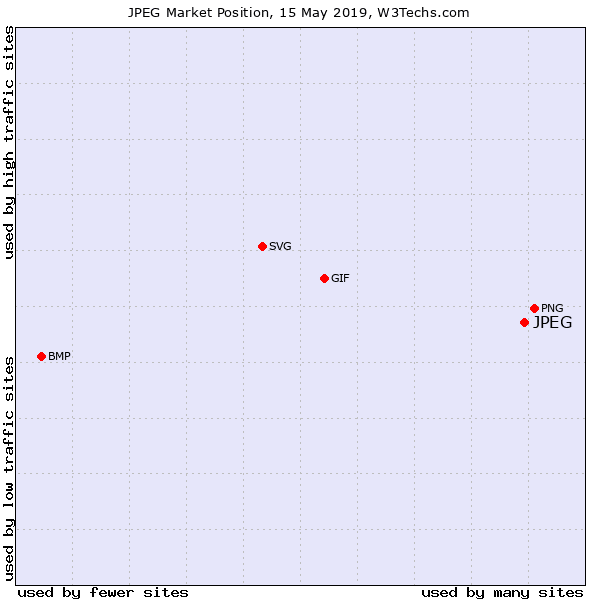
Source: W3Techs
Note: The data in the above chart is of May 15, 2019
With a cloud full of devices it’s obvious why people get confused about ideal image sizes.
Note that image size and image file size are two different things. Here we’ll explain how you can get ideal image size (also called image dimensions).
As part of image dimensions, we’ll also discuss aspect ratios.
Aspect ratios tell the width and height of an image and are written in an “x:y” format.
Remember the time when you tried scaling an image and literally blew it out of proportion? This is exactly what it saves you from. Referring to an image aspect ratio while cropping or resizing images helps you maintain the viability and beauty of the image’s dimensions.
You could refer to this image Shutterstock created to enlist some commonly used aspect ratios.

Source for the image and the table data: Shutterstock
| Aspect ratio | Typical dimensions (inches) | Typical dimensions (pixels) | Ideal for |
| 1:1 | 8 x 8 | 1080 x 1080 | Social media profile photos and mobile screens |
| 3:2 | 6 x 4 | 1080 x 720 | Photography and print |
| 4:3 | 8 x 6 | 1024 x 768 pixels | TVs, monitors, and digital cameras |
| 16:9 | 1920 x 1080 and 1280 x 720 | Presentations, monitors, and widescreen TVs |
With reference to the table above, it’s best to focus on the 1:1 and 4:3 image ratio that are apt for social media, mobile screens, photography, and print.
You might have your own dimension templates based on the content management system (CMS) you’re using.
According to Squarespace, the most ideal size for image optimization on a CMS is 1500 and 2500 pixels.
Here’s a quick and simple answer to spot the most common image sizes for the web.
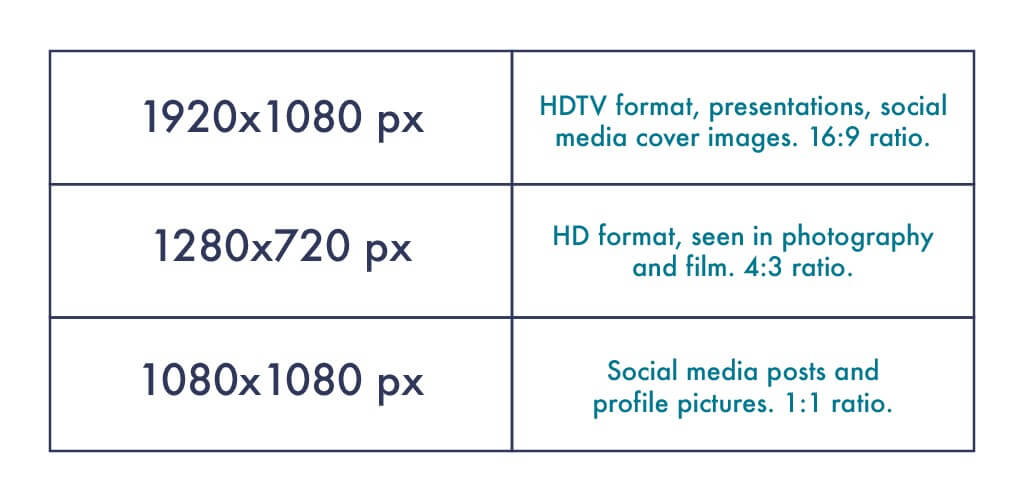 Source: Shutterstock
Source: Shutterstock
From personal observation, I can suggest using 1080 X 1080 pixels and 1500 X 2500 pixels.
If you’re feeling too lazy to go through all these details, you could also try scaling the image from the corner arrow while you’ve pressed the “Shift” key. Works for some platforms.
Search engines have brains without eyes, so unless you name your images right, they won’t be able to “read” your images nor rank you accordingly. This is where your keywords come into play. As I’ve mentioned above, if you name your images well, you can improve your keyword density and chances of ranking.
Let’s explain this with an example:
Name your images in all small letters with hyphens in between and leave no spaces. As you’ve seen, I’ve used the keyword “image optimization” in the “five-tips-for-image-optimization” example. You’ll be surprised with how much that helps in ranking.
You could also use the following to improve keyword usage in your site content:
Plus, if you have an ecommerce site, you could even make good use of structured data to give the search engine more specific details about your products’ color, type, size, and a lot more.
Compressing a file is possibly the simplest yet the most crucial part of image optimization as it directly relates to the website’s loading time. Points one to four prepare you for this final stage of image optimization.
A file size below 70 kb is what you should be targeting. In case of heavy files closer to 300 kb, the best you can achieve is a 100 kb file size. Doing so saves your images from taking extra milliseconds to load while it gives you lossy, compressed images that do not compromise the visual quality.
All you need to do is drop these files on a file compression site and you’re all set. These are some good, free image file compression online tools:
You could be using all these image optimization tips and still get stuck with a site that loads in 13 seconds or even worse. This is when you might want to ask yourself:
Website content, both visual and written, has an intertwined relationship that stimulates emotions and inspires people to further engage with your product or service. People (or at least I) judge a business through its website so feel free to tell us, which was the last impressive website you visited? Or what have you done for image optimization?
The post Image optimization for SEO: Everything you need to know for success appeared first on Search Engine Watch.
The mission of Practical Ecommerce is to publish independent content — articles, podcasts, seminars — that helps ecommerce merchants. What follows are the most popular articles that we published in May 2019, recognizing that posts published earlier in the month are more likely to make the list than later ones.
The post May 2019 Top 10: Our Most Popular Posts appeared first on Practical Ecommerce.
An active comments section can add real value to your blog posts, and WordPress makes it easy to accept these comments, coming with a built-in system preconfigured. But is the native system up to the job? In this article, we’ll share useful comments plugins that can enhance or replace the default WordPress comments system. It... View Article
The post The Eight Best Commenting Plugins for WordPress (2019) appeared first on WinningWP.
While audiences may no longer see a difference between brand- and publisher-created content, each business type can learn from the other on how to succeed in today’s complicated content marketing landscape. Continue reading →
The post How Publishers Can Overcome the Content Marketing Paradox appeared first on Content Marketing Institute.
Over the years, the Single Grain team has used and evaluated hundreds of tools and resources, and we wanted to share our favorites with you.
So here's a list of our top recommendations — we use and love these tools. Check them out!
Kinsta is a managed WordPress Hosting Solution. We recommend Kinsta for their unbeatable uptime, fast loading speed, and daily backups. They have one of the best hosting services we have ever used.
Get Started With Kinsta Today!
If you have anything to do with building our marketing funnels, you should check out ClickFunnels. One of the easiest funnel building software, you can literally build out a well-converting funnel within minutes. It has a drag-and-drop editor, smart shopping cart, email marketing automation, and analytics.
ClickFunnels can directly impact your bottom-line revenue by converting more visitors into customers.
ConvertKit is one of the best email marketing tools in the market. We trust ConvertKit for their user-friendly design, good email deliverability, and amazing customer support.
It especially helps by automating your email follow-ups with your customers, increasing retention and upsells/cross-sells – a crucial part of growing your business.
HubSpot is an awesome inbound marketing and sales tool; the company actually coined the phrase ‘inbound marketing' when they moved marketers away from traditional methods toward inbound ones.
Their platform provides you with a lot of necessary tools and features: CRM, analytic, email automation, pipeline management, and more, under one umbrella.
If you want to grow your business with a robust, time-tested tool, HubSpot is what you need!
SEMrush calls itself the all-in-one marketing toolkit, and we agree: this robust tool gives you a deep dive into your SEO, PPC, content marketing, social media, market research, competitor analysis, PR. It does everything from technical SEO audits to keyword research to backlink audits… for you and your competitors.
We use SEMrush all the time to create and promote content that gets us more traffic, and to keep up with our competitor strategy.
Get A Free 7-Day Trial Of SEMrush!
Monetize your content with Media.net, a good alternative to Google AdSense. The platform makes online advertising simple — you can sign up in just minutes — and their marketplace gives you access to the largest number of advertisers in the world.
Media.net allows you to maximize your revenue with contextual, display, native, and video ads that use smart technology to ensure ads are hyper-targeted to user intent and experience. We love it!
You can start using the above mentioned tools today to grow your business. Meanwhile, we'll keep updating this page to add more resources as we test other different tools and resources.
(Disclaimer: If you buy using any of the above mentioned links, Single Grain may collect a small commission on your Purchase.)
The post Recommended Resources and Tools appeared first on Single Grain.
Can an ecommerce site launch in 2019 and receive organic search traffic without backlinks? Most search optimizers believe it's not possible. I use to think the same. But I keep seeing evidence of the contrary.
The post Can New Ecommerce Sites Generate Organic Search Traffic? appeared first on Practical Ecommerce.
It might not have the reach of Facebook, the visual appeal of Instagram or the comical, witty responses of Twitter, but there’s one thing LinkedIn does have – something that makes it a far more valuable marketing channel for B2B brands:
61 million LinkedIn users are senior level influencers and 40 million are in decision-making positions:

If you want to connect with the decision makers at your ideal-client businesses, LinkedIn is the place to be. But if you are having difficulty connecting with them, creating LinkedIn ads can help you get their attention.
This guide will help you decide if LinkedIn ads are worth your spend and walk you through the process of creating a campaign from scratch, along with handy tips on how to maximize the ROI of your ad spend.
LinkedIn has recently revamped its entire advertising and marketing offering into a new suite: LinkedIn Marketing Solutions. It has a ton of new features, and the good news is that it’s also easier and more intuitive to use than the old system.
Before we dive into the details, let’s take a look at how LinkedIn ads perform compared to other ad platforms so you can determine if they will generate a positive ROI for your spend.
According to the latest statistics, LinkedIn isn’t even in the top 20 most visited sites, while Google, Facebook and Twitter are all in the top 10:

LinkedIn currently sits at number 28. You might be thinking: why bother then?
First of all, LinkedIn has 610 million users and over 26 million company pages. So while it may be smaller in comparison to other platforms, it’s far from small.
Secondly, it’s not all about reach. For advertising, having more potential eyes on your content is meaningless if they’re the wrong eyes. If you’re thinking about advertising on LinkedIn, you’re looking for engaged B2B leads. That’s where LinkedIn excels.
When deciding which platform to advertise on, the real question is: “Will I get value from LinkedIn?” To answer this question, let’s look at the engagement and conversion rates across platforms. This will give a clearer picture of how they compare.
We analyzed the engagement across platforms by looking at the average click-through rate, cost per click and conversion rates across industries in a previous post about Twitter ads (for an in-depth analysis of how these we got these figures, check it out – it’s a cracking read!).
Take a look at the results:

Now let’s add in the figures for LinkedIn.
AdStage analyzed LinkedIn’s performance in Q4 of 2018, looking at 2 billion ad impressions and over 5 million ad clicks. The result was a median CTR of 0.26%. This doesn’t compare well to the other platforms, although it is on an upward trajectory when you look at the year as a whole:

This chart also shows that the max CTR was approaching 0.8%, so it’s at least possible to reach the levels of the other platforms.
In terms of CPC, AdStage put it at $3.72 and on the decline:

In a survey of all its customers, HubSpot found an overall conversion rate of 9% from LinkedIn ads.
Now here’s an updated table that includes LinkedIn:

Learn More:
A quick glance across these numbers isn’t a glowing reference for LinkedIn ads. However, the conversion rate is what’s important.
To demonstrate this, I’ve crunched the numbers into a table telling us how much a lead costs on each platform, given a $1,000 budget:

This shows that, although LinkedIn’s numbers looked weak initially, it actually provides the second-best value per lead.
Facebook is out in front as you might expect with its decent CPC and high conversion rate. Twitter’s poor conversion rate makes it the most expensive by some margin. And Google Ads doesn’t fare much better, losing out because of its relatively low conversion rate.
Of course, this is not an exact science, but it does give you an idea of how the different platforms compare.
To work out your ROI from here, all you need to know is the value that each lead brings you. If the lifetime value of each lead brings in more than $41 from your LinkedIn ads, you have a positive ROI.
Conventional wisdom says you should be aiming for at least a 4:1 ratio, so for LinkedIn ads, if each lead brings you at least $400, you know you are looking at a very healthy ROI.
Clearly, marketers are finding value in LinkedIn ads. A Digiday survey of 290 media buyers using LinkedIn found that 42% of them plan to increase their ad spend on the platform in 2019. And a further 47% said they expected to keep budgets the same.
For B2B marketers, LinkedIn is particularly important. Simply put, it’s a must if you deal directly with other businesses because 92% of B2B marketers include LinkedIn in their digital marketing mix:

With the advanced targeting and forecasting tools now offered and the user base growing, there has never been a better time to advertise on LinkedIn.
Click To Tweet
Dive Deeper: 9 Rules for Creating Ads that Convert
For the basics, check out our guide on how to get started:
In this post, we’ll dive a little deeper into the new format and give you some tips to boost your ROI from LinkedIn ads.
The new objective-based campaign manager walks you through the process of setting up your ads, which takes the opposite approach from the previous one. Rather than creating an ad and then choosing the target audience and where it will be placed, you start with the objective and work backward from there.
It makes sense this way round. Choosing your objective first means that all the decisions you make about the type of ad, the audience, the budget, etc. are based on your objective.
After all, if you were planning a road trip, you wouldn’t start making decisions about which way to turn without knowing where you want to end up. To do that, you need to know your destination before you set off.
The same goes for any ad campaign. Your ultimate objective should influence every decision you make.
Related Content:
Log in to the system and create a new campaign. You’ll see this screen:

The objectives are split into three categories, aligning with the buyer’s journey stages:
Let’s take a look at the options so you can make this crucial strategic decision:
This objective focuses on driving traffic to your website, landing page or LinkedIn Company Page. It allows you to capture leads, give them more information about your product or service or sell to them directly.
If you’re looking to grow your audience, this objective deals with how many users engage with your content. It is used to drive followers to your Company Page and increase social engagement, shares, comments, etc.
Use this objective to get more eyeballs on your videos by sharing them with more people. It helps you target the people who are most likely to view your videos to increase engagement and clicks.
Note: Brand Awareness, Website Conversions and Job Applicants are all grayed out and billed as “coming soon”. But LinkedIn advises using the Website Visits objective, choosing “Automated Bid” and maximizing for “Impressions” for Brand Awareness, “Conversions” for Website Conversions, and choosing the appropriate ad format for Job Applicants.
Once you’ve chosen your objective, you are taken to the next stage where you select who you want to see your ad.
Related Content:
Choosing the right audience is crucial to getting the best ROI from your campaign. Paying for 1,000 views from interested parties is far better than paying for 1,000,000 views from people who will never bring you any revenue.
Happily, there are a ton of new features that make it a lot easier to target the right people.
Here’s what the Audience dashboard looks like:


As with all the major social ad platforms, you can target by location and demographics like age and gender, which are all very useful.
But LinkedIn really comes into its own with its business targeting options. You can dive into specifics, targeting by industry, job title, education, job experience, and interests (based on which LinkedIn groups people follow).
It’s in the individual’s interests to make sure that this data is up to date and accurate. With LinkedIn, you can be pretty sure this data is legit, whereas on platforms like Facebook, people often give false information or hide personal data. This makes it a very powerful targeting tool.

In the above example, we’re targeting people who are connected with anyone at IBM, Apple or Tesla, in the IT services industry at a senior level.
Being able to drill down to this level of detail has huge potential to boost your ROI. And it’s something unique to LinkedIn advertising.
There are a couple new features we should look at in more detail.
This feature allows you to leverage other people’s professional networks to target like-minded individuals. It only includes first degree connections to the employees of companies with over 500 employees, so the likelihood is that these people actually know each other.
Lookalike audiences changed the game when they were introduced by Facebook, allowing marketers to target people similar to their best customers, thereby reaching a far larger audience of similar individuals.
A recent study of Facebook marketing data shows that Lookalike audiences make up about 60% of overall spend in Facebook advertising campaigns.
The good news is that this feature is now available on LinkedIn! Just be careful not to overuse it. If you are running a campaign with multiple audiences targeting different demographics and you’re using Lookalike audiences to target similar people, there’s a risk of audience overlap.
If the same people are seeing your ads multiple times, you risk audience fatigue which could damage your reputation and hit your conversion rates hard. Effective management of your campaigns will reduce the risk of this happening.
LinkedIn offers eight formats. As you can see, the handy Forecasted Results panel on the right-hand side shows you projected results for each type of ad, based on the audience you’ve selected:

This should help you choose the appropriate ad format, which will depend on your audience and what you’re hoping to achieve.
Note: Some of these ad types require you to set up a Company Page.
Now that your ad is ready to go, you need to decide how you’re going to bid for placement. You have two options:
With the first, you’ll only pay when someone clicks on your ad and LinkedIn will try to show it to people they believe (based on past data) are most likely to engage with your ad (and make them money).
Your alternative is to pay for every 1,000 people who see your ad. If you write compelling copy with a high CTR, this can actually save you money and boost ROI. But it’s better suited for campaigns designed for brand awareness, where your goal is to get as many views as possible.

After you select the type of bid, you set the actual amount. LinkedIn will automatically recommend a range of bids based on what others are already doing. I recommend starting by bidding a little higher than the bottom of this range to make sure you get some decent placement.
You can also set a daily budget and LinkedIn will attempt to match your spend to that amount (although they do warn that your costs may be up to 10% higher than your budget).
I recommend that you start with a small daily budget of $10-20 when creating new ads. After a week or two, you will have a better idea of which ads are performing well and can increase your budget (and your bid amount) if that makes sense for you.
As you change the variables, the Forecasted Results will update. You can use this to optimize your bids and get the most for your money.
Pro Tip: If you are consistently coming in under budget, it may be a sign that your bid is not competitive enough to win placement. If this is happening, just bump up your bidding a little bit and you should see your number of impressions (and, hopefully, clicks) grow.
Learn More:
Once you’ve set up your campaign it’s time to create an ad. For text ads, you’ll need to provide four key things on the left-hand side:

The ad destination is the page you’d like to send people to when they click on your advertisement. That can be a page that you or your business already have on LinkedIn or it can be any external destination by URL, such as a specific product landing page.
You’ll then need to add a catchy headline that grabs the reader’s attention at first glance. Try using emotional and rational trigger words to make sure that they click to read your ad.
Your ad copy should expand on your offer. Make sure to incentivize the reader to click through by highlighting the key benefits of your offer here.
Lastly, you should include a small, but eye-catching image. Avoid using anything complex or confusing because people will only see it as a small thumbnail for a quick second as they scroll past your ad. Many people choose to use their logo here. But do whatever makes sense for you.
Pro Tip: You can test multiple versions of the same ad easily on LinkedIn. Once you’ve finished creating the ad (in a few steps) you can easily duplicate it and return to this page to tweak the copy and images.
If this is your first LinkedIn Ad, you’ll need to enter your billing information now. LinkedIn will not display any of your ads until this information is filled out and verified.
If you don’t have access to the company credit card or are waiting on someone else for this information, you can continue making new ads and campaigns simply by navigating away from this page (just return to the ads homepage) and continuing to work.
Your account will display a large warning until that information is entered and your ads won’t run. But there’s no reason not to get everything set up first.
Note: Once you add your billing information, it may still take a little bit of time before your ads start to run. LinkedIn has a review process through which they submit most ads, especially for new accounts.
Once you create your first ad, the dashboard will transform into this:

Of course, it will be full of zeros until your ads start getting some traffic and data points to measure.
Once the data arrives, you’ll be able to use the charts here to track all the important metrics of your campaigns, like CTR and Avg. CPC.
Which metrics are “good” depends on your business and your marketing objectives, but generally you’ll want to focus on minimizing CPC and CPM numbers as that means you’re spending less per customer that you reach, maximizing the number of people you can reach with your budget and maximizing your ROI.
If you’re running multiple ads on the same objective (for example, generating leads for your PPC Advertising business), you should keep an eye on their comparative CPC. If you notice that one is significantly outperforming the others, you should put more of your budget into that ad. This will help you reach more people at a lower cost and maximize your ROI.
It’s important to also track the quality of clicks you are getting. To do this, you should set up conversion tracking in Google Analytics or a similar tool.
If you noticed that leads coming in via one of your campaigns are converting at an extremely low rate, you need to adjust that ad to better qualify your leads. Otherwise, you’re spending money to attract people who aren’t interested in your offer.
Likewise, if you have a campaign running with a low CTR or high CPC, but the traffic is converting very well comparatively, you might consider letting it run despite the engagement metrics.
At the end of the day, it’s CPA (cost per acquisition) that matters. So if you’re paying $2 per click, but converting 1-in-4 clicks, you’re actually outperforming the campaign that costs $1 per click but only converts 1-in-10.
For B2B marketers, LinkedIn must be part of your strategy. Looking at the numbers, it rivals Facebook as one of the most cost-effective ways to reach and engage a powerful audience.
On top of that, LinkedIn’s new ad platform makes the process intuitive and offers intelligent features to help you maximize your ROI.
As you run your campaigns, remember to keep an eye on the numbers over the medium to long term, but don’t worry about monitoring campaigns day-to-day too much. In fact, I’d urge you to avoid doing that. Campaigns fluctuate naturally every day and you could make poor decisions if you get wrapped up in those daily shifts. Just check in on them once every two weeks or so to make sure that your costs are reasonable and your leads are converting well.
If you need some help with your LinkedIn ads, that’s where we come in. Our results-focused digital experts can give you the level of support you need to get the most from your LinkedIn ads!
The post The Ultimate Guide to Creating a LinkedIn Ads Campaign appeared first on Single Grain.


You've heard it before, but we'll repeat it here: For every $1 you spend on email marketing, you can expect an average return of $32:
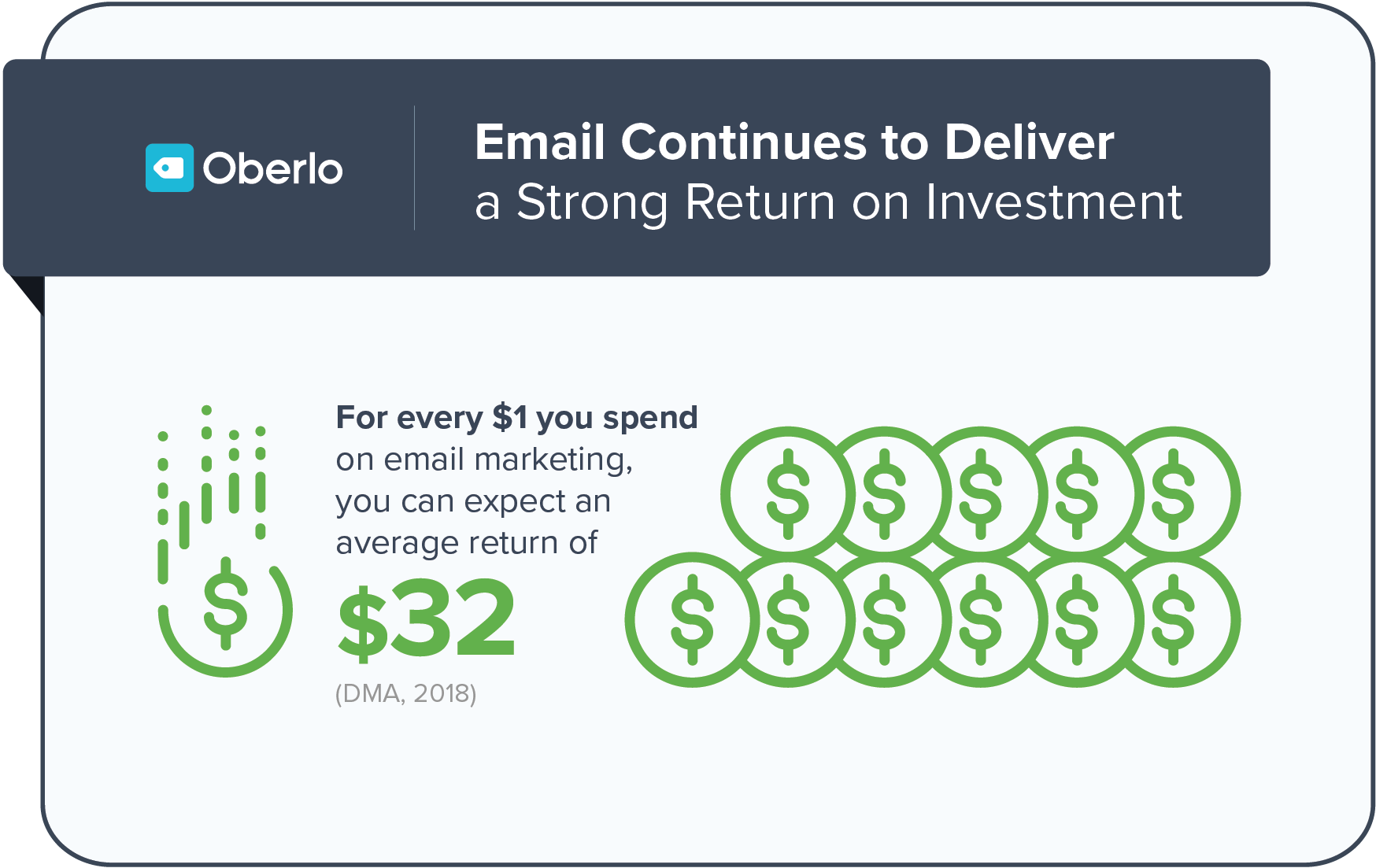
Simply put: You need to get people to give you their email addresses.
Of course, that’s often easier said than done. Consumers these days are savvy. They aren’t just going to hand over the keys to their inbox without good reason — and spamming them into submission isn’t going to get the job done.
If you’re serious about making email marketing work for you, here are seven creative ways to collect email addresses without being spammy.
You may have seen ‘spin the wheel’ pop-ups on various websites (both Neil Patel and I have used them). The gist is that website visitors are given the option to spin a wheel — Price Is Right style — in order to claim a coupon or other incentive:
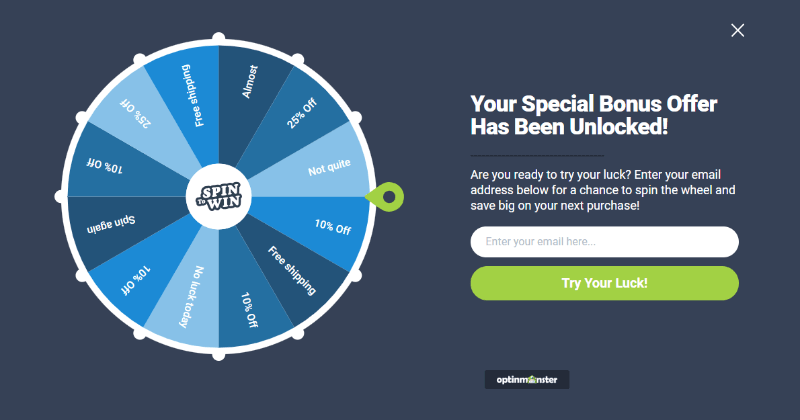
According to OptinMonster, makers of the wheel pictured above:
“Gamified opt-ins have been known to turn 2-3% conversions rates into conversions rates of 30% or more.”
That makes them a great option for capturing email addresses — if you use them correctly. For best results:
Like everything else, ‘spin the wheel’ opt-ins are worth a test. Don’t assume that they’ll solve all your email capture problems. But if creating one is appropriate for your brand, put one up on your website and see what the results tell you.
Dive Deeper:
No matter what your offer is or what you’re giving website visitors in exchange for their email addresses, your opt-in mechanism needs to be visually distinct from the rest of your text. Otherwise, you risk visitors missing it as they scan through your pages.
In the past, copywriters commonly used yellow boxes to set important information apart from other text. Here’s an example:
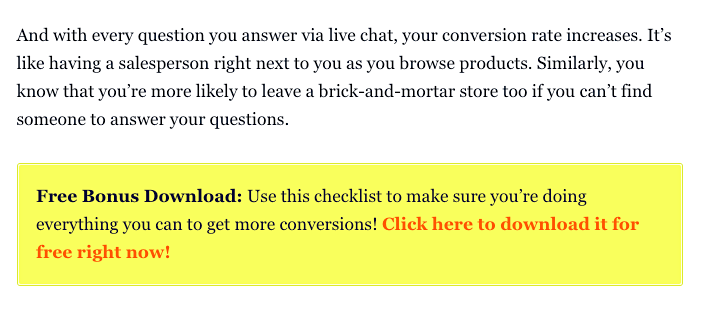
That said, this strategy has been around for a while, which means it may not be as effective as it once was. That doesn’t mean you shouldn’t set your opt-in mechanism apart at all. It just means that you need to test different visual cues to see which variations help you capture the most email addresses, such as:
Here's an example with an image:
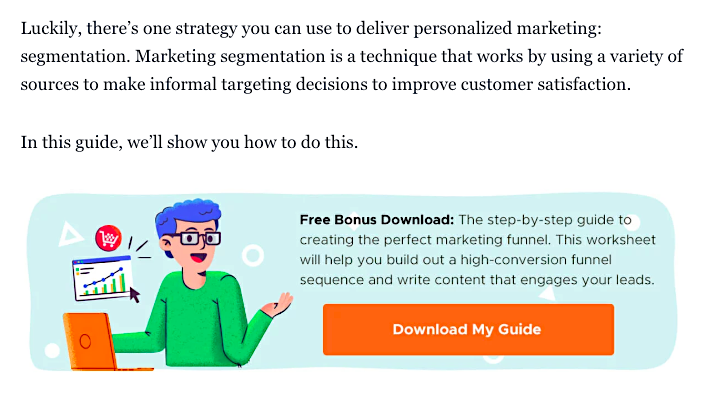
The combination that’s right for you won’t be the same as what’s right for another website. Test variations until you’re sure your visitors aren’t missing your offer.
Some people call this strategy a “content upgrade,” but basically, you’re already producing great content. Why not produce a little more – maybe an in-depth guide or something that offers additional value – and then only make it available to those who opt in?
Here’s how Brian Dean used a lead magnet it in a post about using lead magnets (very clever!):
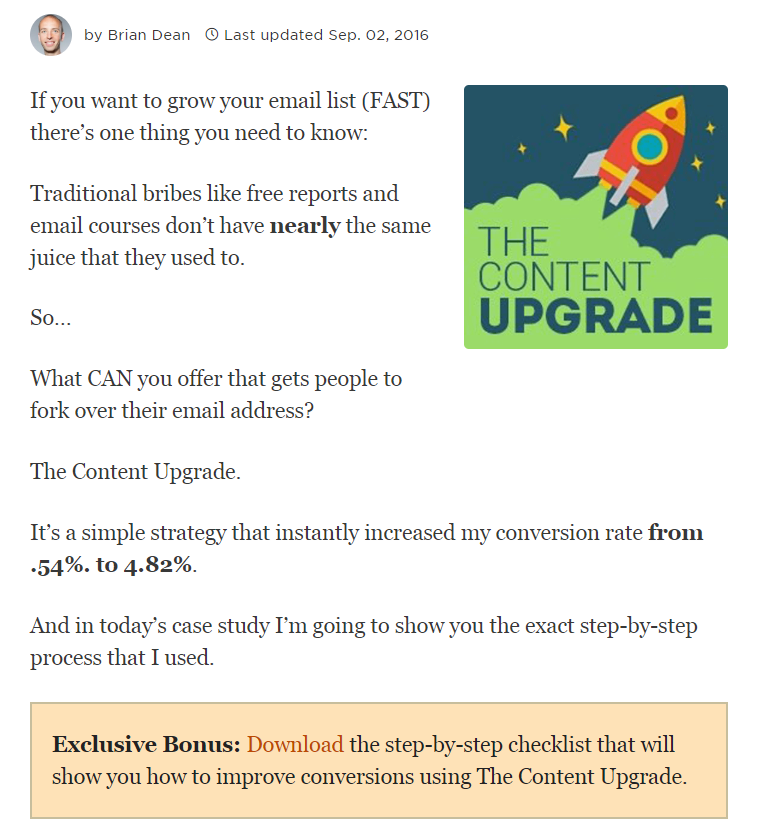
His full article is hugely valuable. But interested readers can still engage further by opting to download his “step-by-step checklist,” which isn’t available to the public at large.
That’s just one way you could do a lead magnet. You could also:
As of now, the kinds of lead magnets that are working best for us include “skyscraper-style” lead magnets (for example “400 Business Lessons from Silicon Valley’s Top Entrepreneurs”) and checklists (such as our Marketing Funnel worksheet, which you can access here).
As with the ‘spin the wheel’ promotion described above, the value of your lead magnet has to be worth the perceived cost of opting in. A lot of marketers used to recommend giving away e-books as your lead magnet, for example, but these days that strategy is so overused – and the quality of many e-book lead magnets became so low – that most visitors see very little incentive to opt in.
It all comes back to value. Test the different strategies above when choosing your lead magnet. When you see a spike in your email opt-ins, you’ll know that you’ve hit on the right giveaway.
Dive Deeper:
This tip may not apply to you if you only ever publish content on your website. But let’s say you do podcast tours or events like Neil and I do, or if you do video collaborations or guest articles with other websites. When you’re on different mediums, what you can do is create a “pretty” link that’s easy to remember.
Let’s say Neil starts his own podcast called “The Neil Show” and I wind up going on it as a guest. Rather than just telling people to find me online, I could give them a special promotion hosted at a memorable link like “SingleGrain.com/TheNeilShow.”
Behind the scenes, I’d use a tool like the Pretty Link WordPress plugin to set up a cloaked link at that URL. That way, when people came through it, not only could I show them a special, targeted promotion hidden behind an opt-in form, but I could also use the link to track how many opt-ins that one particular appearance achieved. That would help me figure out where I want to put my time in the future to grow my list even further.
Again, it’s not spammy, because, in theory, I’m using this link to offer new visitors something that’s really valuable. What exactly that is would depend on who I’m speaking to and what their audience needs, but I’m always going to be focused on leading with value.
If you go on Neil’s site right now, you’re going to see two things. First, you’re going to see the “Spin to Win” promo I described earlier down in the left-hand corner. But you’re also going to see his main opt in, which asks you to enter your URL for a custom website analysis:
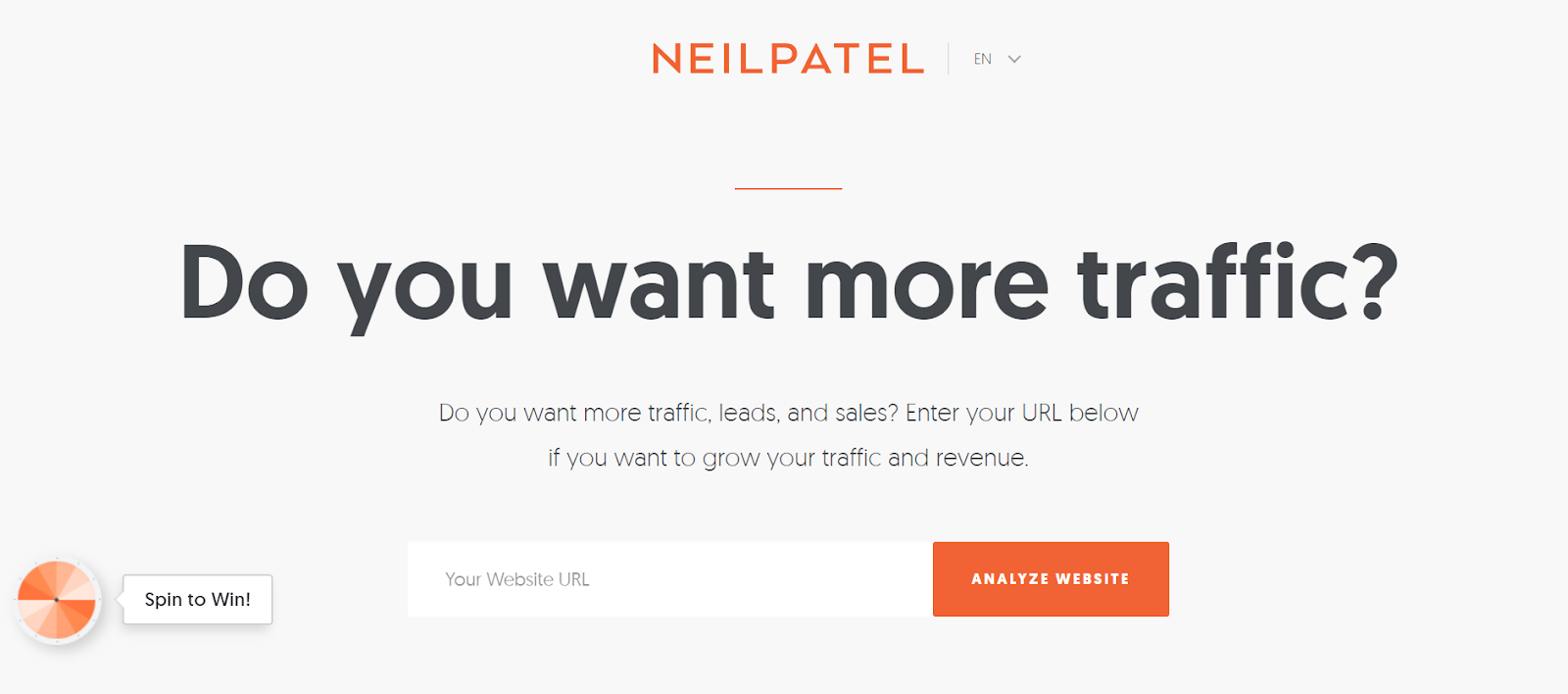
If you put in your website URL, the program crunches the numbers behind the scenes to reveal various details about your website’s SEO and social presence.
Once it’s complete, you'll see a screen like the one below that invites you to enter your information for assistance resolving issues that the tool has found:
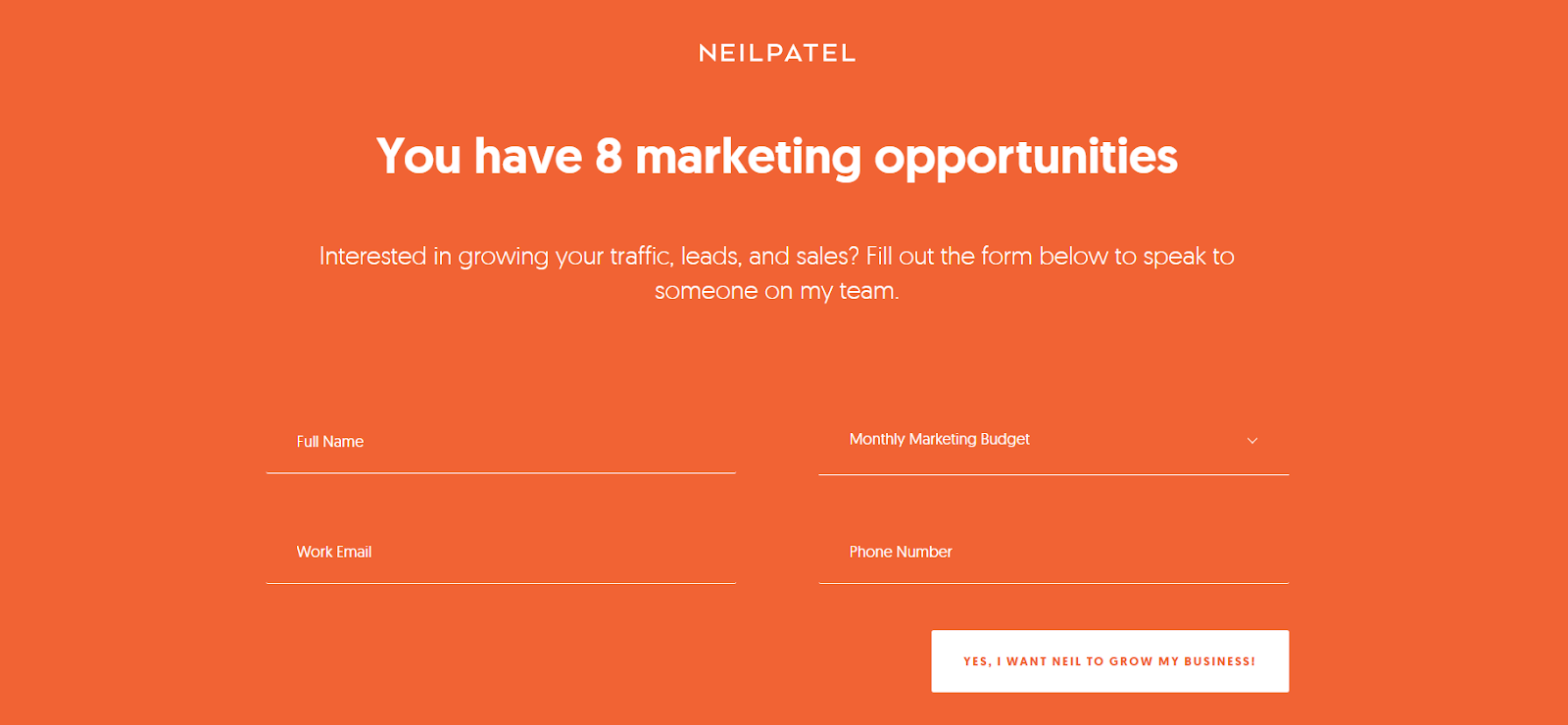
It’s a great opt-in option, because it immediately proves the value of sharing your information. The tool has identified marketing problems that Neil can help with! Why wouldn’t you fill out the form in order to grow your business?
Of course, setting up something like this is more complicated than dropping a spinnable wheel or lead magnet into your pages. You’ll probably need to hire a developer to build your own custom tool. But once it’s set up, you may find that it’s one of the highest-converting opt-ins on your site.
Dive Deeper:
On a related note, if you don’t want to put all the effort into creating a custom analysis tool, you can use a service like Outgrow to build an interactive calculator for your website.
Say you’re a marketing agency. One way you could gather opt-ins on your site is to create a calculator that helps website visitors calculate the ROI of their current campaigns. People love interactive content, and chances are, if they’re willing to go through the data input process that your calculator requires, they’ll be willing to give you their email address as well.
Outgrow offers an ROI calculator as one of its standard templates, but you can also build your own calculator, based on your specifications:

I’ve talked about MobileMonkey before – a Facebook Messenger marketing platform that makes it easy to build chatbots and execute marketing automations without writing a line of code:
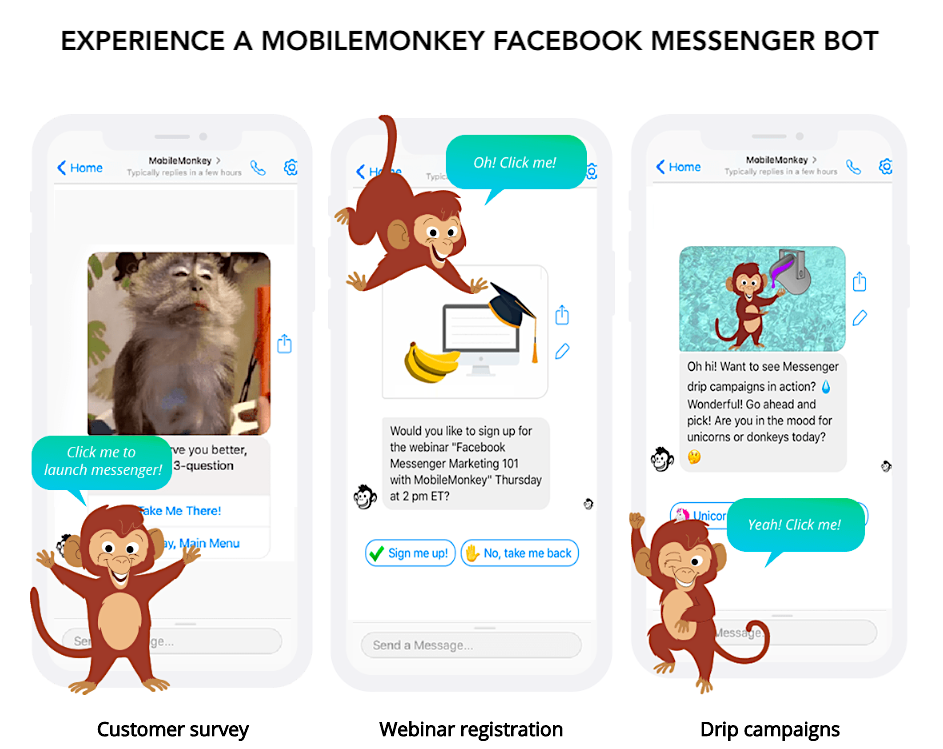
But what makes the tool so powerful isn’t just that you can use it to get prospects to opt into chatting with you on Facebook Messenger. You can also use it to get people to give you their email addresses, making it a two-for-one deal for businesses that need to grow their audiences on both platforms.
The seven strategies described above will help you get email subscribers onto your list without running the risk of being seen as spammy by your audience.
But if you don’t have a plan for what you’ll do with email addresses after you’ve captured them, what’s the point of even using these strategies in the first place?
Email marketing isn’t guaranteed to deliver that $32 return on every $1 of spend. In fact, your numbers could be a lot lower if you aren’t proactively managing your list. Here are just a few tips to keep in mind:
In theory, every person that opts into your email list should be immediately directed down a pathway towards greater engagement with your business. That workflow is going to look very different from one business to the next, but it might involve:
The only way you’ll know which messages will be most effective for your audience is to test different options. Just like you A/B test your website, make sure you’re A/B testing both the messages you send subscribers and the way you send them.
And that doesn’t just mean testing your broadcast messages. The Litmus 2018 State of Email Survey found that:
Make sure you’re testing each different type of message you send, as well as the triggers and segmentation rules you use to send them.
Dive Deeper:
I’ve talked a lot about the importance of segmentation and personalization on this blog before, but just to hammer it home, keep in mind that, according to ActiveTrail:
You’ll get better results from your email marketing campaigns when you’re more confident that you’re sending the right message to the right subscriber at the right time.
You’ve probably seen this effect in action yourself. If you’ve ever unsubscribed from a list because the messages you were receiving weren’t relevant to your interests or needs, you know why segmentation and personalization matter. And with tools like Segment and Hull on the market, there’s simply no excuse for sending irrelevant messages.
If you aren’t using the strategies I’ve described above, pick the one that seems most interesting (and most relevant to your brand) and test it. But keep in mind that this list isn’t comprehensive. There are plenty of other opt-in strategies out there, so if these aren’t the right fit, or if they don’t produce results for you, don’t get discouraged.
Do your homework. Choose another opt-in strategy to test. Keep going, because as soon as you find the right combination of opt-in mechanism and offer for your audience, you’ll be able to take advantage of the huge benefits that email marketing has to offer.
The post 7 Creative Ways to Collect Emails Without Being Spammy appeared first on Single Grain.
Google is always looking for the best ways to provide the most useful results to users. It’s what has allowed Google to dominate the search engine market for so long and, it has kept the SEO industry evolving.
In the beginning, there were quick answer boxes (remember those?) and, most recently, the introduction of “How-to” snippets.
“How-to” snippets aim to provide step-by-step instructions directly in the SERPs for instruction-based queries. There are two types of “How-to” snippets that you can find in the wild.
This type of schema is mobile specific. And that’s important because it means absorbing huge amounts of SERP real estate. It has also been confirmed by Glenn Gabe, that you can capture both a featured snippet and the “How-to” carousel/list view.
This left very little space for your competitors but also, forced websites to now think more logically about how they structure their content.
The immediate question is “which type of How-to snippet is best for my audience?” You guessed right, it depends.
Take, for example, a crafting site audience. Visual and creative people. In this instance, you may consider using image rich snippets.
It’s like anything else in SEO, test it and tweak based on your results.
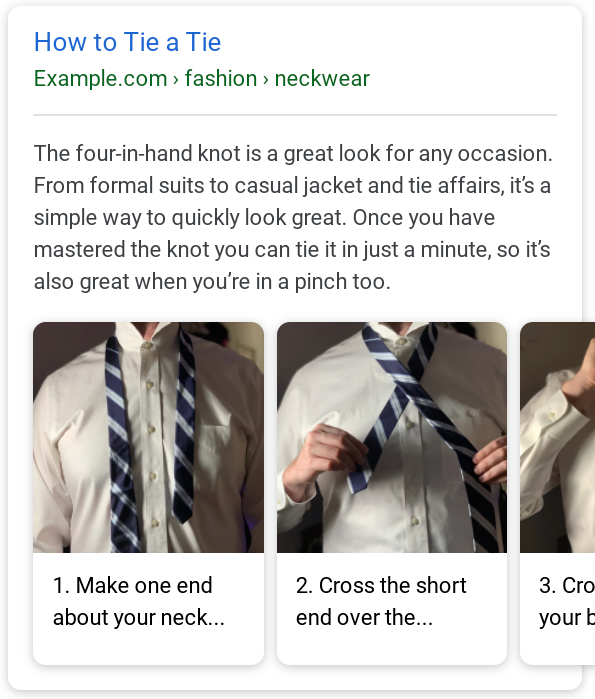
Source: Google Search developer tools
Pretty eye-catching, isn’t it?
And then the accordion view (the standard “How-to” rich result).
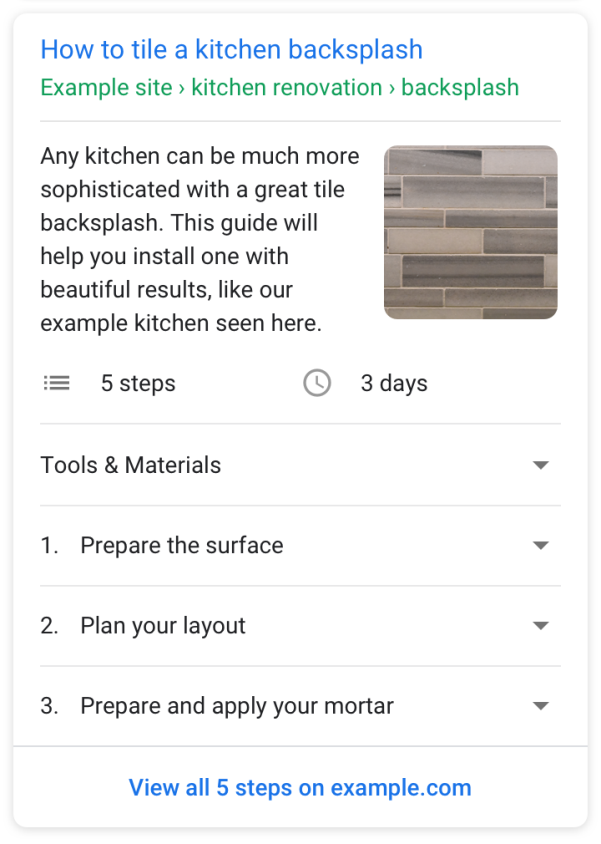
Source: Google Search developer tools
My immediate preferred option is the accordion. For a number of reasons:
The only major difference which may influence user behavior after the click is the ability to anchor link to each step. The standard markup doesn’t allow for this to happen, however, the image carousel does.
Interesting to see how that changes user engagement in the future.
Your best source of information is Google’s search developer tools.
However, we often find that it can become complicated for those less-techy SEOs, which could dissuade implementation and testing.
We don’t want that. Which is why we’ve broken down each element of the schema and explained what it means.
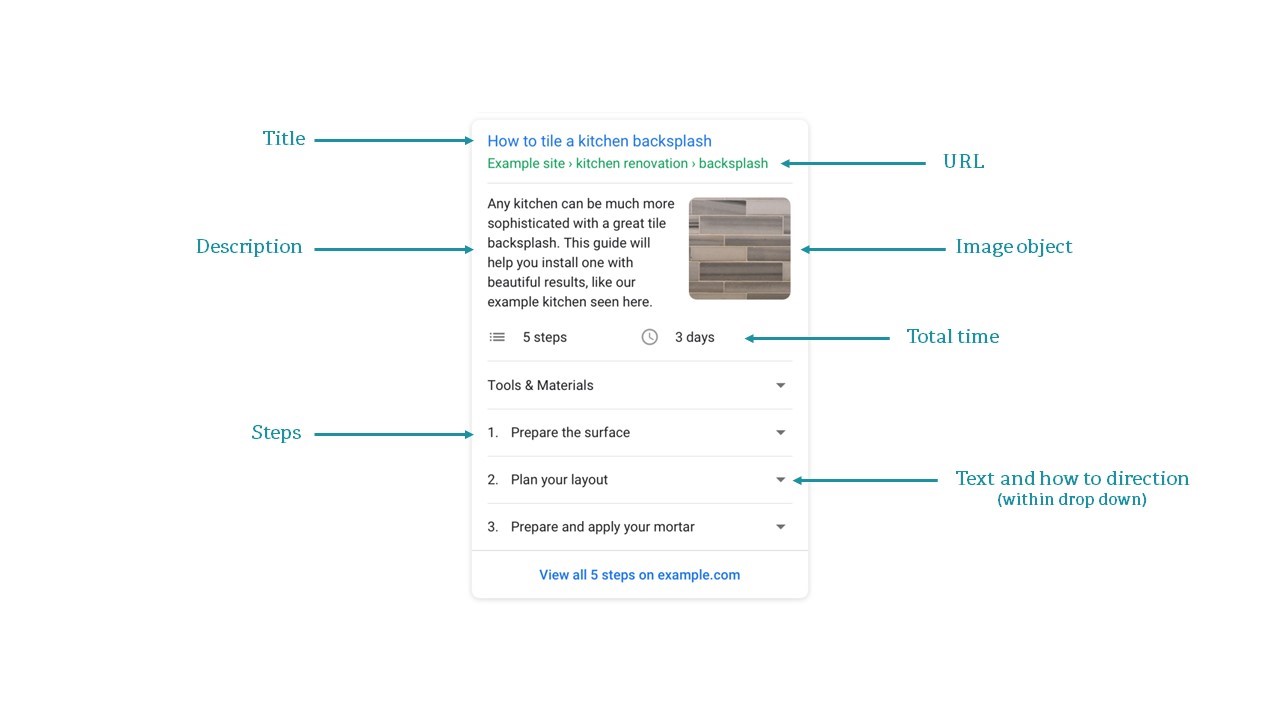
This solely defines which type of schema you’re using on the page. In this instance, we’re going to use the type “HowTo”.
You can think of this as the title of your snippet. In basic SEO terms, it’s the equivalent to the page title attribute of a normal webpage.
Here is your chance to describe what you’re breaking down into steps. Keep this short, precise, and interesting enough to still encourage the click.
The “HowToStep” is where we tell Google we’re about to outline a numbered step to appear in the SERPs. Google counts the instances of the “HowToStep” to understand how many steps are there in total.
This sits underneath the “HowToStep”, “HowToDirection”, or “HowToTip”. This is your basic explanation of one of the three aforementioned “HowTo” elements.
This is where it can get tricky. Using the “HowToDirection” allows you to bullet point your text, rather than use a single paragraph. In our view, “HowToStep” is the easiest element to implement.
The best approach here is to add anchored links to each step of your “How-to” snippets. It’s only used for image-rich results. So, if you’re using the accordion, just add the main page URL to this element.
This can be used to define the main image of your snippet. It can also be used to populate the carousel steps found in image-rich “How-to” schema.
This is a critical element. The time defines, to your user in the SERPs, how long something will take to complete. If you’re not familiar with the ISO 8601 format, it’s worth visiting this Wiki page.
We, as SEOs, are always looking for simple ways to complete complex tasks. Adding this markup to your pages should be no different.
We recommend letting Google do the hard work for you. You shouldn’t have to be a full-fledged web developer to start working with Schema markup.
Use the code generated in Google’s example to then tweak as you see fit.
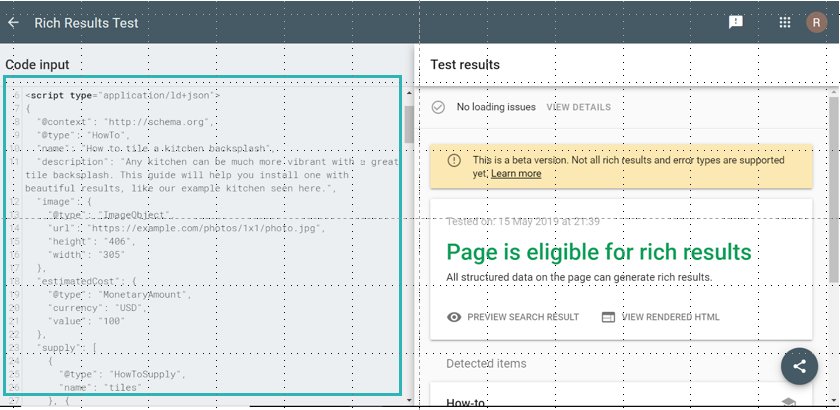
Example image used for educational purposes, Ryan Roberts, Zazzle Media
You can easily change all elements of valid How-to Schema, generated by Google itself.
Some of the HowTo markups may not be relevant for what you’re trying to do, so, just begin removing sections which are relevant.
Let’s say I own athomefitness.com and I have an article about how to do crunches.
I’d take the code generated above, and tweak where I see necessary. Here’s how that might look:
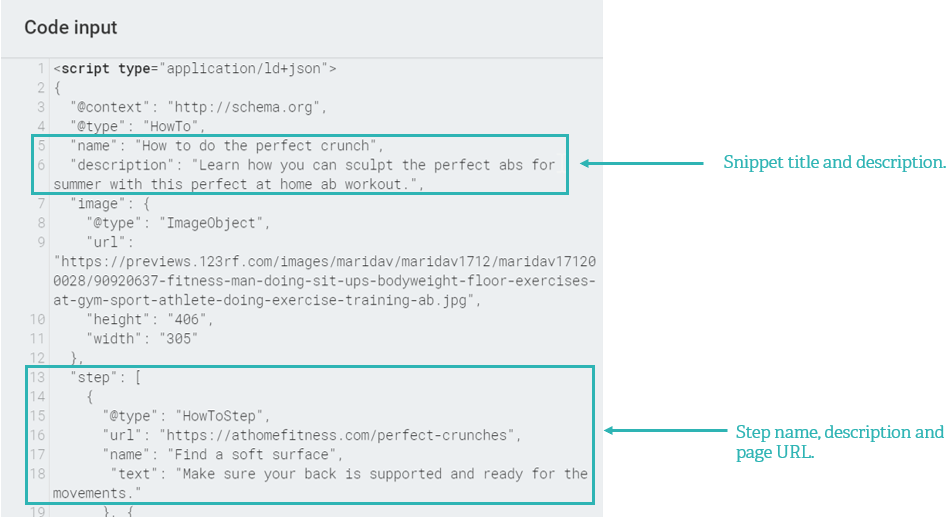
Example image used for educational purposes, Ryan Roberts, Zazzle Media
And, to preview how this looks in the SERPs, you just select ‘preview search result’ in your code generator and it’ll give you two options to choose from.
In this instance, I’ve marked up my page to display a standard list.
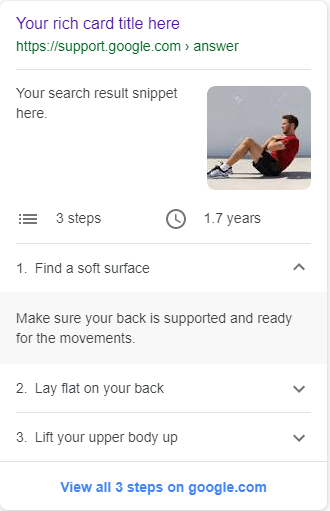
Example image used for educational purposes, Ryan Roberts, Zazzle Media
Unfortunately, Schema is a fickle character and will very quickly point out mistakes that you’ve made.
The most common errors normally come from missing required properties (known as class type) or syntax errors (uncategorized errors).
![common markup errors example missing , or ] in array declaration](https://searchenginewatch.com/wp-content/uploads/2019/05/common-markup-errors-example-missing-or-in-array-declaration.png)
Source: Schemaapp.com
This usually means you haven’t closed an open bracket somewhere in your code. Unfortunately, you have to dig into the code itself to find it. Thankfully, Google highlights the line in which the error appears on the Schema generator.

Source: Schemaapp.com
Very similar to the syntax error above, this error means you have not successfully closed your {, or you have forgotten to add a comma before the start of your next opening {.

Source: Schemaapp.com
This type of error means you’ve omitted or mistyped the value of your “How-to” step. In this scenario, it could be:
Note: A simple spelling mistake could throw your whole script out of sync.
You can jump the queue and request that Google crawls your URL sooner to make sure it gets around to your content and (hopefully) finds your new “How-to” markup.
An easy way to do this is with the URL Inspection Tool (similar to “Fetch as Google”).
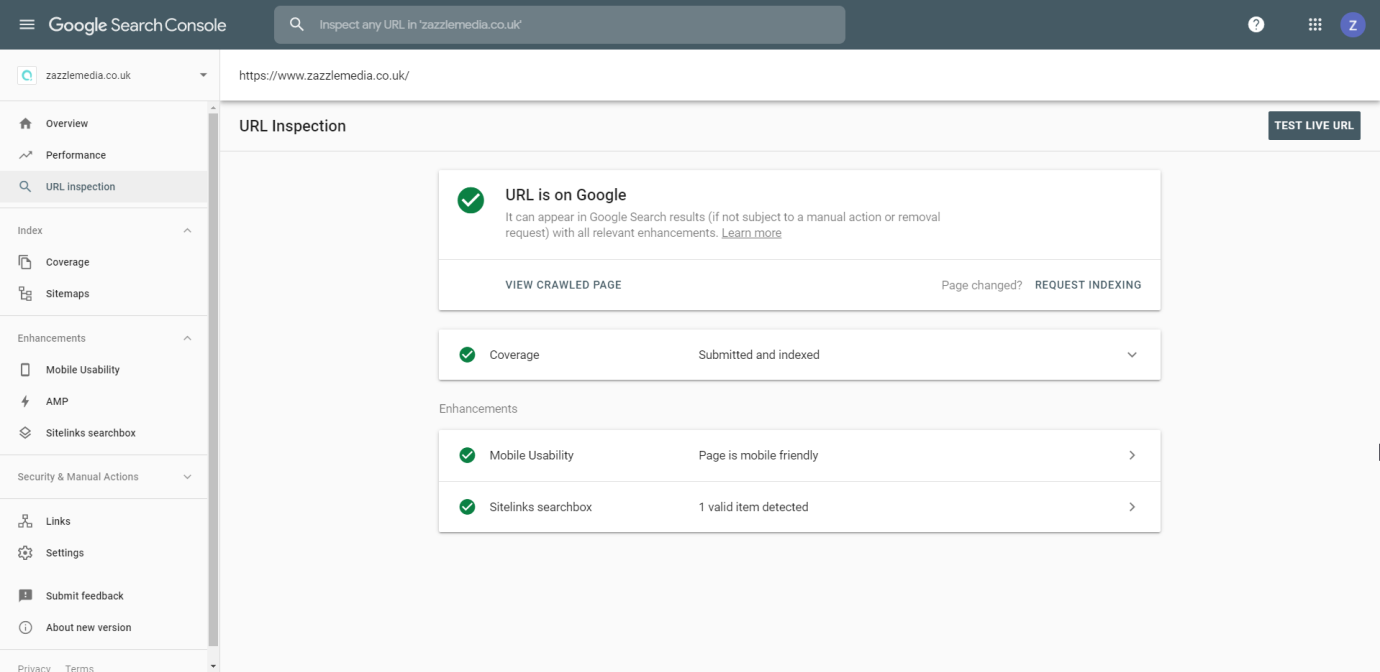
Source: Google Search Console for zazzlemedia.co.uk
From our initial testing, we’ve found that indexing happens pretty much immediately; irrelevant of the size of your site.
So, if you’re impatient and eager to see if your hard work has paid off, this is a great way to validate that Google has identified the changes to your URL.
After successfully implementing your Howto markup, it’s important that you track content performance.
Are clicks increasing/decreasing? Are impressions going up/down?
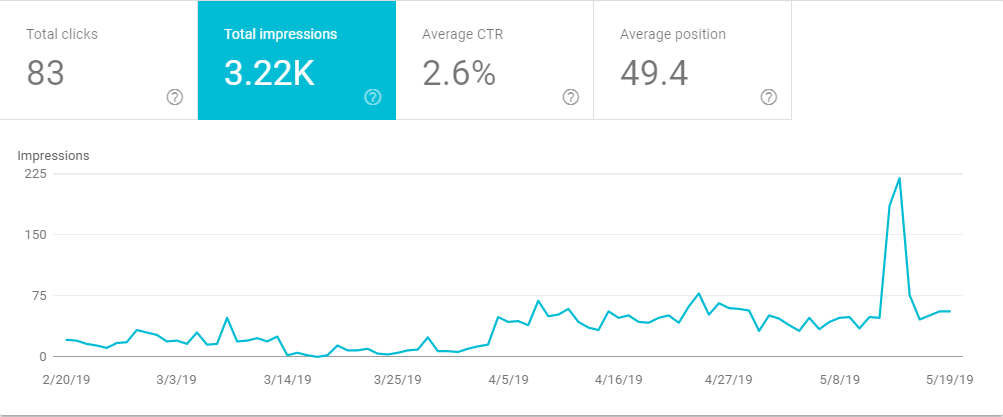

Source: Google Search Console for papanicksdriving.co.uk
The likelihood is you’ll be a very early adopter of this markup, which will make it a quick way to eat up large amounts of SERP real estate.
However, it’s always important to monitor whether or not this markup is a real benefit to your site. This markup aims to enhance your content, not pay detriment to it.
“How-to” schema should begin making its way onto sites much more in the near future as clients (and SEOs) start to see the immense benefit of absorbing as much SERP real estate as possible. Despite the negative connotation of a zero-click search.
We’d love to hear about any tests and progress you’ve made, please feel free to leave any comments below to let us know!
Ryan Roberts is an SEO Lead at Zazzle Media.
The post A guide to implementing Google’s “How-to” schema appeared first on Search Engine Watch.